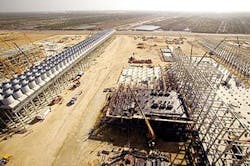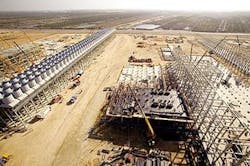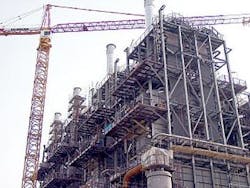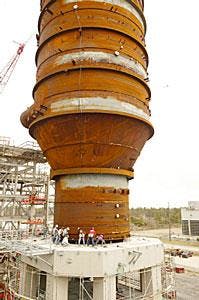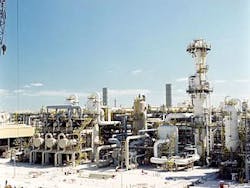Clean-fuels initiatives push refining construction projects
Clean-fuels initiatives, driven by government-mandated low-sulfur fuel specifications in the US and elsewhere, continue to push refining expansion and revamp construction projects, according to the OGJ worldwide construction report survey. More than $1 billion will be spent on clean-fuels projects during the next several years.
In the US, several clean-fuels projects are under way or nearing completion. Bechtel Corp., San Francisco, announced completion of Shell Oil Co.'s, hydroprocessing expansion projects. Hydrocracking and hytrotreating capacities were expanded at Shell's Puget Sound, Wash., Deer Park, Tex., Norco, La., and Convent, La., refineries. Bechtel's 32,000 b/d diesel hydrotreater project for the ConocoPhillips Rodeo, Calif., refinery project is expected to be completed by December 2004.
Outside the US, Caltex Refineries Ltd., Sydney, plans to spend $295 million to upgrade its Australian refineries at Kurnell and Lytton to cut emission levels of sulfur and benzene. Albeit still in the planning stages, the projects are scheduled to be completed by January 2006.
Foster Wheeler Ltd., Clinton, NJ, reported details on five clean fuels projects. Two of the projects, the Clean Fuels Gasoline Project at BP Oil UK Ltd.'s, Essex, UK, refinery and its Total SA's Lindsey Clean Fuels Project at South Humberside, England, refinery, have been completed. Ongoing projects include the Samir refinery upgrade at SA Marocaine De L'Industrie Du Raffinage in Mohammedia, Morroco; the Sulfur- Free Mosgas Project at ExxonMobil Corp.'s Southampton, UK, refinery; and the Future Fuels Project at New Zealand Refining Co. Ltd.'s Marsden Point, Northland, N.Z., refinery.
null
Hovensa LLC, owned by Amerada Hess Corp. and Petroleos de Venezuela SA, plans to invest $400 million in upgrades for its 495,000 b/d refinery at St. Croix, Virgin Islands. The upgrades will enable the refineries to meet upcoming clean-fuel regulations. No additional capacity is planned.
Details on other low-sulfur fuels projects taking place in refineries in Colombia, Italy, Serbia and Montenegro, Spain, Turkey, Angola, and Kazakhstan were reported for the survey.
null
Refining
The 2004 OGJ Worldwide Construction Survey shows that the number of refining projects is down slightly, down to 325 projects listed in this report compared with 338 in the 2003 fall report, because several major projects have been completed and removed from the list.
Outside the US, new grassroots refinery construction projects are under way, from the initial stages of financing for Nigeria's first privately financed refinery to InterOil Corp.'s nearly completed refinery in Papua New Guinea, the nation's first.
In Nigeria, a proposed 12,000 b/d refinery moved closer to construction phase after the US Export-Import Bank approved a loan guarantee for more than $10 million. The refinery project is a joint venture of Energy Management Corp., Houston, and Ventech Engineers, Pasadena, Tex. The refinery will be built in modular units and located at Eket in Akwa Ibom state. Phase 1 consists of a 6,000 b/d crude distillation unit, and Phase 2 will involve another 6,000 b/d distillation unit and a 4,000 b/d catalytic reformer-hydrotreater. Phase 1 is slated for a February 2006 start-up and will process 35.8°gravity Qua Iboe crude. Upon completion, the refinery cost is projected to be $65 million.
InterOil, Toronto, recently announced that its 32,500 b/d Port Moresby, Papua New Guinea, refinery is 91% complete and on target for a June 2004 testing and commissioning schedule. The refinery will process BP Singapore Pte. Ltd.-supplied crude and sell the majority of the products to Shell Overseas Holdings Ltd. The total anticipated cost for the refinery is $130 million. InterOil also plans to develop supporting retail assets and to continue petroleum exploration in the area.
State firms China National Offshore Oil Corp. Ltd. (CNOOC), Sinopec, and PetroChina Co. Ltd. plan to add 1.04 million b/d of crude processing capacity to refineries in China over the next 6 years. According to Dow Jones Business News Report, three new refineries are planned to process 600,000 b/d and the rest of the capacity will be achieved by expanding six existing refineries. The strategy will entail closing some small refineries while expanding others. Much of the additional crude required to feed the refinery expansions must be imported. China's petroleum demand is forecast to increase by 12%/year to 8 million b/d by 2020, 5.6 million b/d from the current 280.
A new China refinery has been proposed by joint venturers Shell Petrochemicals Co. Ltd. and CNOOC. The complex is to be sited alongside the Nanhai petrochemical project currently under construction in Guangdong province, near Daya Gulf. Shell and CNOOC submitted an application for permits to the local government and expect to receive approval within 6 months. Front-end engineering and design (FEED) studies are under way.
The International Alliance Group (IAG), Houston, won the lead contractor role for numerous fluid catalytic cracking unit (FCCU) projects. Using licensing and technology from UOP, Des Plaines, Ill., IAG is involved in projects for Marathon Ashland Petroleum LLC (MAP) in Canton, Ohio; for INA Industrija Nafte in Sisak, Croatia; for BP PLC in Coryton, England; Lavera, France, and Grangemouth, Scotland, with licensor and Halliburton Co. unit KBR; and for MOL Hungarian Oil & Gas in Szazhalombatta, Hungary.
MAP, Findlay, Ohio, has undertaken extensive plans for expansion of its refineries. Various new and expanded FCCUs, crude and vacuum units, hydrotreaters, alkylation units, and reformers are planned for its facilities in Kentucky, Illinios, Michigan, and Louisiana. All projects should be completed by November 2005. Fluor Daniel of Aliso Viejo, Calif., Jacobs Engineering Co. of Pasadena, Calif., and Stone & Webster Inc. of Baton Rouge, La., won the majority of the MAP projects' engineering work while licensing was provided by UOP, Des Plaines, Ill., and Axens Group PLC, Surrey, England.
Not all construction projects reported here involve new or expanded equipment. ConocoPhillips plans to purchase used alkylation, coker, crude, FCCU, and isomerization equipment from Premcor Inc.'s mothballed Hartford, Ill., refinery for transportation and installation at ConocoPhillips's Wood River, Ill., refinery. The units are needed to permit the refinery to process heavy, low-cost crudes. The additional units will not increase current distillation capacity at that facility.
Crown Central Petroleum Corp., Baltimore, reported that no construction or expansion projects are planned its Pasadena, Tex., refinery, or at its subsidiary La Gloria Oil & Gas Co.'s Tyler, Tex., refinery as both of those properties are still for sale.
Petrochemical
In petrochemical construction news, the spring 2004 OGJ Worldwide Construction Survey has 197 projects listed in the report, compared with 192 in the 2003 fall report.
New projects replaced completed projects almost one for one.
China's rapidly growing plastics industry has prompted an upward spiraling demand for petrochemical products. Demand is expected to continue to grow at 7.4% annually.
According to the State Economic and Trade Commission of China, chemical producers there plan to increase annual production capacity of ethylene to 9 million tonnes/year (t/y) to meet 60% of domestic demand by 2005. China currently has 18 ethylene complexes that produce 5 million t/y of ethylene.
Shell-CNOOC's world-scale Nanhai petrochemical complex near Daya Bay will be the largest foreign investment joint venture in China, with a price tag of $4.5 billion. Major contracts have been awarded to primary contractors Bechtel, Sinopec Engineering, and Foster Wheeler.
The petrochemical complex will produce 800,000 tpy of ethylene, 560,000 tpy of styrene monomer, 250,000 tpy of propylene oxide, 320,000 tpy of monoethylene glycol, 240,000 tpy of polypropylene, 300,000 tpy of linear low-density and high-density polyethylene, and 150,000 tpy of low-density polyethylene. Project completion is scheduled for fourth quarter 2005.
Also in China, BP Sinopec, and Shanghai Petrochemical Corp. formed a joint venture named Shanghai Secco Petrochemical Co. Ltd. that will build a major petrochemical complex near Shanghai. The complex will produce 600,000 tpy of polyethylene, 590,000 tpy of propylene, 250,000 tpy of polypropylene, 500,000 tpy of styrene, 300,000 tpy of polystyrene, 260,000 tpy of acrylonitrile, 500,000 tpy of aromatics, and 150,000 tpy of butadiene. The complex has a price tag of $2.7 billion and is expected to come onstream in mid-2005.
Chiyoda Corp. of Yokohama, Japan, contributed to the petrochemical construction report with a list of construction projects in Saudi Arabia (methanol, ethylene), Iran (urea), and China (bisphenol-A, propylene oxide). All projects include new units.
Two new ethanol plants are planned for Canada. Husky Energy Inc., Calgary, reported that it would go forward with construction plans for a $90 million, 1,560 b/d ethanol plant at its Lloydminster, Sask., heavy oil upgrading facility. The development will advance Husky's plan to market ethanol-blended fuels under the Mother Nature's Fuel brand. When completed at the end of 2005, it will be the largest ethanol facility of its kind in western Canada.
Suncor Energy Products Inc., Calgary, received government approval to build a 2,420 b/d ethanol plant near Sarnia, Ont. The $120 million project should be completed by mid-2006. Some funding will be provided by Natural Resources Canada's ethanol expansion program.
null
Gas-to-liquids
Qatari officials are moving ahead with plans toward becoming the gas-to-liquids capital of the world by 2010. If all Qatari GTL projects proceed to fruition, that would add up to a total of six GTL plants to produce more than 900,000 b/d of GTL fuels.
The 34,000 b/d Oryx GTL plant at Ras Laffan is under construction and due on stream in 2005. It is backed by a combine of Qatar Petroleum and a joint venture of ChevronTexaco and Sasol Ltd.
The 70,000 b/d QatarShell GTL project near North field is in the engineering stage and is expected to be completed by 2009. The partners plan to double the capacity at this plant at a later date.
ConocoPhillips and Qatargas signed a statement of intent to build a $5 billion, 160,00 b/d GTL plant for start-up in 2010. Phase 1 would begin with 80,000 b/d, and Phase 2 would double that capacity. In late 2005, after prefeasibility studies are completed, and if the plan moves forward, this project will be added to the OGJ GTL list.
Other proposed projects include a 140,000 b/d Marathon plant, a 180,000 b/d ExxonMobil plant, a 185,000 b/d Ivanhoe Energy Inc. plant, and a 120,000 b/d ChevronTexaco plant.
Gas processing
Despite public fears in the wake of the deadly explosion, due to a gas pipeline leak, at Sonatrach's Skikda, Algeria, natural gas liquefaction plant on Jan. 20, major petroleum companies are inclined to move forward with LNG import-export projects. LNG is seen as a viable solution to the looming gas supply shortfall problem in North America. Liquefaction costs have dropped 35-50% over the last 10 years, making project economics more attractive to operators. But some issues still must be overcome.
According to Stephen Shaw of Det Norske Veritas (DNV) Oslo, speaking at a Mar. 12 DNV seminar in Houston, those issues include consumer anxiety, skepticism of LNG-industry published safety studies, and the not-in-my-backyard syndrome.
Shaw demonstrated the variance of perceived hazard consequence zones by listing the US Coast Guard's 26 mile zone, the Bureau of Mines 76 mile zone, and Massachusetts Institute of Technology's 127 mile zone.
"Getting the physics right with this is something the industry needs right now," Shaw said.
DNV initiated a consortium study to independently determine credible scenarios and to calculate hazard zones based on substantive scientific data to be contributed from the study sponsors. At this time 17 potential LNG terminal developers have joined the consortium study. Final results and models will be presented by DNV at the 19th Annual CCPS International Conference on Emergency Planning, Preparedness, Prevention & Response on June 30, in Orlando, Fla.
The US currently has four LNG regasification terminals on the East Coast and one liquefaction plant in Alaska that exports LNG to Japan.
The industry consensus seems to be that four or five more import terminals, culled from the 14 proposed terminals listed in our report, might be approved by US energy regulators and built in the US during the next 10 years.
The US Federal Energy Regulatory Commission recently relaxed certain rules to allow operators more freedom to control access and pricing at their terminals. By this action FERC hopes to stimulate more capital investment in LNG projects. FERC, the US Coast Guard, and the US Department of Transportation are conducting a study to develop a model for calculating vapor and thermal hazards associated with LNG operations.
One of the projects moving forward in the US is BP's Crown Landing LNG project, to be located in Gloucester Co., NJ. Crown Landing is in the planning stage and, if built, is expected to be completed in 2008.
Crown Landing is a prime location for an LNG import terminal because New Jersey is a major hub for gas transmission lines serving the gas-hungry northeastern US.
BHP Billiton Ltd., Melbourne, is moving forward with its Cabrillo Port project, a proposed floating LNG storage and regasification terminal to be moored permanently to the ocean floor 14 miles off Ventura County, Calif.
The project would require onshore and offshore pipelines. Initial public hearings were held at the end of March, and permit approvals might be obtained from the US Coast Guard, US Maritime Administration, and California State Lands Commission by early 2005.
ExxonMobil has applied for permits to build two LNG receiving terminals on the Texas Gulf Coast. The first, Vista Del Sol LNG Terminal LP, will be in San Patricio County near Ingleside.
The second, Golden Pass LNG Terminal LP, will be at Sabine Pass, near Port Arthur. ExxonMobil is considering other onshore and offshore sites. The company plans to import at least 15.6 million t/y (2 bcfd) from its RasGas project in Qatar and has sent out tenders for eight newbuild LNG ships for delivery between 2004 and 2007.
Nigerian National Petroleum Corp., ENI SPA, ConocoPhillips, and ChevronTexaco have undertaken FEED work for the Brass LNG Ltd. project to be located in the central Niger Delta. The facility would be operated by ENI's Nigerian Agip Oil. Co. and comprised two liquefaction trains of 5 million t/y each. If constructed, the plant is slated to be on stream by late 2008.
TransCanada Corp., Calgary, and ConocoPhillips cancelled plans to develop the Fairwind LNG project at the former US Navy fuel depot near Harpswell, Me., after Harpswell residents voted against leasing the site to the partners.
Marathon cancelled plans for an LNG complex in Baja California, Mexico, due to public and political resistance.
In Bolivia, the Pacific LNG project, led by Spain's Repsol-YPF SA, has been cancelled due to massive civil protest against exporting the gas.
And Calpine Corp., San Jose, Calif., withdrew plans for the Eureka, Calif., LNG regasification complex after encountering local opposition spurred by safety and environmental concerns.
null
Sulfur
According to the survey report, 47 sulfur recovery projects, totaling 14,748 tons/day (t/d), are planned or under way.
In the US, Valero Energy Corp., San Antonio, awarded a contract to Chicago Bridge & Iron Co. of Hoofddorp, Netherlands, to design and build sulfur recovery and tail gas treating units at Valero's refineries at Three Rivers, Tex., and Ardmore, Okla. Each location project will recover 130 tonne/day of sulfur to support operations for Valero's clean-fuels initiative.
National Iranian Oil Co., Tehran, plans a 130 tonne/day sulfur recovery unit at Bandar Assaluyeh in Iran. The unit will recover sulfur from gas. Lurgi Oel Gas & Chemie GMBH, Frankfurt, will license the technology as well as take the lead in the design and engineering work. The unit will be completed this year.
Tonen General Oil in Wakayama, Japan, plans to revamp one train of its sulfur recovery facility to increase capacity to 140 tonne/day. Parsons Energy & Chemicals of Pasadena, Calif., will undertake design work.
Parsons currently has sulfur projects also under way in Germany, Italy, Kazakhstan, Kuwait, Morocco, UAE, and the US.
null
Pipelines
In pipeline construction news, BP reports ongoing progress on the Baku-Tbilisi-Ceyhan (BTC) pipeline. BTC will carry crude from the onshore terminal at Sangachal, near Baku, through Georgia to a yet-to-be-completed marine export terminal at Ceyhan on the Turkish Mediterranean coast.
Construction on the 1 million b/d BTC pipeline began in 2003 and is targeted for completion in 2005. BTC's partner pipeline, the Baku-Tbilisi-Erzurum project, should be completed in 2006.
It's a three-horse race for the Bahamas- to-Florida gas transmission service.
Although each plan varies slightly, the general idea is to construct an LNG receiving and regasification terminal in the Bahamas and transport gas to Florida via pipeline.
AES Corp., Arlington, Va., already has received final approval from FERC for its Ocean Express pipeline project. The 54 mi., 24-in. pipeline would transport 842 MMcfd from the Bahamas to Florida starting in November 2005.
Competing with AES is Tractebel SA, Brussels, with its proposed Calypso gas pipeline. Calypso, with a price tag of $144 million, would run 96 miles of 24-in. pipeline to bring 832 MMcfd to the Florida shore. Calypso has received preliminary approval from FERC.
The third competitor is El Paso, with its 128 mile Seafarer pipeline. That pipeline would transport 750 MMcfd from Grand Bahama Island to the Port of Palm Beach. Seafarer, if built, would be completed in 2007.
Bechtel reported ongoing progress on its six Thailand pipeline projects. The pipeline for the Malaysia-Thailand joint development area Block A18 to Chana, Thailand, is currently under construction and on schedule for completion during first quarter 2005.
The project includes a 168 mile, 34- in. gas pipeline with 1.02 Dcfd design capacity.
The second project is a 120 mile, 42-in. offshore pipeline, currently in the engineering stage, which will connect Arthit Block B15 in the Gulf of Thailand to the Erawan riser platform. That pipeline design capacity is 1.75 bcfd.
Bechtel's other offshore pipeline in the Gulf of Thailand will run from the Erawan PTT riser platform to Map Tha Phut, Thailand. That expansion project will include 264 miles of 42- in. gas pipeline and is currently under engineering.
The fourth project is a 60 mile, 36- in. line to run from Chana to Changlun, Malaysia, to carry 750 MMcfd.
Another pipeline, from Map Tha Phut to Bang Pakong, Thailand, will include 69 miles of onshore 36-in. pipe to carry 1.2 bcfd.
The sixth project in Thailand is the new 153 mile, 8-in. products pipeline, currently under construction to connect Chana to Prai, Malaysia.
